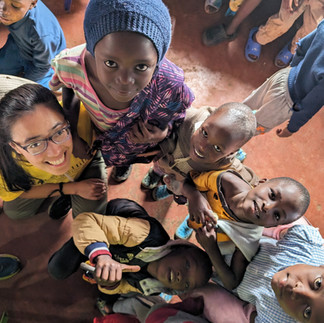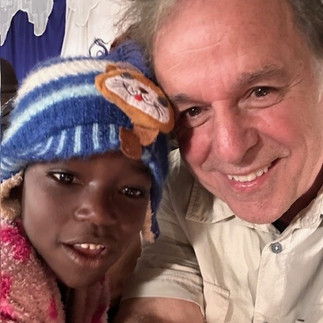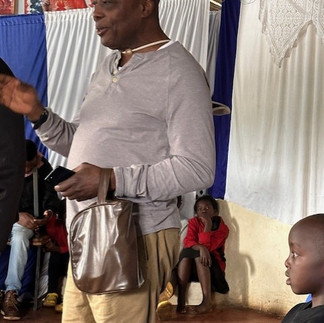January 13, 2024, En route from Nairobi to Amsterdam somewhere over the Red Sea
- SHGO Admin
- Jan 14, 2024
- 7 min read
[En route from Nairobi to Amsterdam somewhere over the Red Sea] I write this final update on our January, 2024 SHGO trip to Sierra Leone and Nairobi, Kenya, while 34,000 feet in the air, trying to pull together my myriad thoughts and emotions on the things we saw, the people we’ve met, and the experiences we’ve all had. The two purposes of this trip were to dedicate a new school we funded and had built in the rural bush/jungle region outside of BO, Sierra Leone, and to review the progress being made on the new school we are building for over 350 children living in Kibera—the largest slum, embedded in the city of Nairobi, Kenya. To those ends, we were more than successful. The new school in Sierra Leone will serve over 200 children in the six most remote villages we serve. This new “Garland Friends Primary School,” is the first school this area of Sierra Leone has ever seen, and the children will be the first beneficiaries of an education in this area—ever. The dedication could not have been more celebratory and uplifting. Villagers walked in from miles away, and government officials traveled out to the bush to participate in what you and I in the US might view as a rather small remote school, but for Sierra Leone, is viewed as an important and critical step to uplift the nation through educating their children. I want to thank all of our good friends and church communities in Garland, Texas, for helping to raise the funds through their annual “Running 4 Clean Water” event, along with donors from Massachusetts who also contributed toward the cost of building this new school. Without the generous contributions of the “Running 4 Clean Water” event in Garland, Texas, Grover and Nancy Sherlin, and Ron and Laura Watkins, in Texas, this school would not have been possible.
It’s impossible for me to share with you the full extent of what these seemingly small gestures mean to people who have never had a school, or in our other programs in Sierra Leone, may never have had a medical clinic to attend or be able to deliver baby safely, or drink clean water. Over the years SHGO and our partners have done just that;—we have committed ourselves to addressing the simple needs of the poorest of the poor, and for that I’m thankful and grateful to all of our donors.
My Clark university students who have traveled with me, those who have joined every trip for the past 15 years, and our Seven Hills staff, from all over the world who have emotionally supported this work and celebrated in all these small successes that we’ve enjoyed, cannot be thanked enough.
Following our work in Sierra Leone we flew across the continent to the largest slum in Africa, called Kibera, which is embedded in the heart of Nairobi. Along with this blog you’ll see photos that I took yesterday in our last visit back to Kibera, prior to leaving. Trying to describe the conditions there, once again, is impossible to describe, with 500,000 people living in one square mile of shrinking land. Houses are built from sticks and mud, held together by wire or with nails that barely keep the building intact. I know that whenever I think life is hard in the US, or I have challenges to face, and I bemoan those concerns, I merely have to think about those many, many thousands of people that I know and I’ve come to love in a place like Kibera . They live in the worst conditions imaginable and yet they smile, and they have always welcomed us with gratitude for whatever we’ve been able to do. Take a look at the photos attached, and imagine 500,000 people living in those conditions in this very compressed area. From the very first moment I stepped foot in Kibera nearly 12 years ago, I had with me Clark University students who’ve been remarkable in their willingness to dive into understanding why these conditions exist. At the same time, on every trip, I’ve had Seven Hills staff who have come, looked at the conditions, and have invariably said to me after the trip, “now I understand why SHGO is so important.“ The new school that we are now building in Kibera will offer education to over 350 slum children—many of whom have never been to school. To them, this new “Bethel–Kibera Primary Schoo” is a miracle. The school should be completed in early March and will welcome hundreds of children with thousands on a waiting list.
With the help of future hopeful donors, that I have not yet identified, we will be able to buy each of the 350 students a new uniform. In Kenya, and throughout most of Africa, children wear uniforms to school which depict a color of the school, and which provides all children a sense of equality regardless of the wealth or poverty of their families. When I return to America I need to raise $3500 which is $10 for every uniform we need to buy. And so, if you’re moved to want to do one small thing for a child living in the slums of Nairobi, Kenya, perhaps you can buy them their school uniform for $10. It would be a tremendous help.
In accomplishing our primary goals of dedicating our school in Sierra Leone, and in following up on the status of our new school being built, we were successful. But, we’ve accomplished so much more. In Sierra Leone we met with Village chiefs, and talked about the possibility of adding a remote satellite medical clinic so that women don’t have to walk the dangerous miles to come to our birthing center at our Bandawa campus. We also talked about adding additional classrooms for our large school in BO, which would allow us to build a 4-classroom high school for grades nine through 12, and which would be located at our library, and then add more younger children to our BO School. This would allow us to serve an added number of very young children and reduce the tremendous waiting list to attend.
In Kenya, we had an opportunity to meet with both the Minister of Health and the Minister of Commerce, both of which work directly for the President of Kenya. We discussed the need for more staffing at Seven Hills Foundation and the possibility of bringing up to 450 Kenyan students to Massachusetts, Rhode Island, and New Hampshire—all of whom would be desirous to work in the United States, and continue their education. Both Ministers enthusiastically endorse this proposal and will be asking the President of Kenya to work with our US State department to provide a special demonstration, or pilot initiative, which would allow visas for these young people to enter the United States and to work for Seven Hills Foundation for up to three years, prior to a mandatory return home back to Kenya.
Attached are several photos which depict my discussions with these officials in Nairobi, and we hope to move forward with presenting the President of Kenya and the US State department a detailed proposal in the days ahead. Just before leaving Kenya, our team that came with me this year, Andy, Tracy, Sunday, Brian, Patrick, returned for one final visit to the slums of Kibera, to spend time with the children and witness their happiness and joy over the possibility of this new school, starting in just a few short weeks. Singing, dancing, jumping up and down, was in every corner of Kibera as we were walking through. I hope that in the months ahead, I can return again to Kibera—along with additional Seven Hills staff and an equal number of Clark University students—to dedicate this remarkable new facility. I could go on and on about thousands of details associated with the children with whom we held hands, danced, and hugged. I leave with a sense of melancholy knowing that there is still so much work to do in the world for so many people who have quite literally nothing—no clean water, no toilets, no refrigeration, no school supplies, no healthcare, a lack of food—quite literally nothing. But yet they survive, they laugh, and they have none of the cynical attitudes towards life that we seem to be overwhelmed with in the United States. These are incredibly loving, caring, deeply spiritual people—whether they be Muslim, Christian, or other forms of faith.
I am so looking forward to returning back to my home in Worcester, and at the same time, will leave a part of my heart in the bush of Sierra Leone and in the slums of Nairobi Kenya. I’d like to offer my final thoughts about our team—Andy and Tracy, (my former School of Management, Clark University alum), Brian and Sunday, staff of Seven Hills Community Services, Patrick, our photographer who I’ve known for nearly 25 years doing much of the professional photography work for Seven Hills, along with Nancy and Grover Sherlin, who joined us in Sierra Leone. They were all nothing short of “magnificent” and I will forever be in their debt for their friendship, and, more importantly, for what they gave to the hundreds of children and women that we met throughout our stay. And so to them, I say “thank you”. Their families and friends should be so incredibly proud of them for dealing with cold showers, long days, and the endless demands placed upon them.
If you’ve been reading this, thank you for following our work. I can only hope that I could have been more articulate in describing the depth of what we do and how critically important our work is, but alas, I am just not up to the task. I hope, however, that I’ve shared some of the important work we do. This collection of my Clark University students, Seven Hills staff, and donors, have accomplished more over the years than I could have ever imagined.
I’ll be back home in just a few hours in my nice, soft bed, holding on to my dear wife, but a part of me will remain here in Africa. Bless you all.
—Dr. David A Jordan.























































Comments